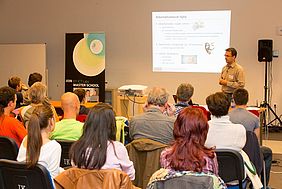Just like the Trento Node, the Budapest co-location centre also was a popular scene on 27 September.
Researchers’ Night is a massive event taking place every year in about 300 cities all over Europe. Two EIT ICT Labs locations, Trento and Budapest joined the activities this year to promote science and fun learning and to show the co-location centres are pleasant community spaces, where young researchers can work together on the latest inventions.
The programs at the EIT ICT Labs Budapest co-location centre (CLC) took place in the midst of great interest, with more than 120 visitors showing up. Those, who were interested in information security and spyware could listen to Levente Buttyán, who held a presentation about targeted cyber-attacks. Children were guided by Kinga Farago to develop their logic skills by Handorino, a serious game. "Glasses know what you see!” Takumi Toyama showed behind the scenes of augmented reality with 21th century digital glasses. Tomás Timon and Adam Nagy presented a real time public transport timetable application enhanced by social media.
The Budapest Associate Partner Group not only introduced its activities at its headquarter but also on the central stage of the Budapest Researchers’ Night. Zoltán Horváth, director of Budapest Associate Partner Group participated in a round table discussion together with András Lőrincz and Károly Farkas introducing the project Digital Cities, Jam-Free Traffic, which is part of the three-million-euro granted research project coordinated by the EIT ICT Labs Budapest Associate Partner Group.
In the meanwhile, at the CLC, Levente Buttyán's presentation attracted more than 60 people with the title In the target: Digital snipers AKA targeted information security attacks of our time. The goal of this research is to develop a security framework, which allows the detection of targeted cyber-attacks against critical infrastructures and which supports the recovery from such attacks, incident handling as well as forensic analysis aiming at determining the root causes and the impact of the incident. The protection of our critical infrastructures against cyber threats is not sufficiently effective, the framework to be developed in the project aims at filling this gap.
Before and after the presentation the audience could participate on demonstrations. The Handorino logical game was especially interesting for the children. 6 year old kids arrived with their parents to play with this application even after 10.30pm. The product is an internet based game developing the children’s inductive reasoning in a playful way. The product has been developed by IT experts and mathematicians at the Eötvös Loránd University (ELTE) recently, but the idea behind it was initiated by the leading researchers of the Institute of Education, University of Szeged. The game called Handorino (http://www.handorino.com) is currently in a test phase and is available for free.
Takumi Toyama’s demonstration: “Glasses know what you see! – An introduction of 21st century digital glasses, which augment our reality” was as popular among high school students as Handorino was among the children. Today – thanks to the advancement of eye tracking technology – a computer is able to recognize what you see and can help you by inferring what you need in a particular situation: for example when you need a translation of a foreign word. The researcher demonstrated how a computer can help people using an eye tracker and ‘Augmented Reality’ (AR) glasses.
The parents were excited about the traffic application presented by Tomás Timon and Zsolt Ádám Nagy: ‘Real time public transportation timetable based on social network data’. Researchers from the Budapest University of Technology and Economics demonstrated mobile applications based on community detection, which points forward to the vision of a 'smart city'. The applications are able to specify the expected arrival time of public services, and on the other hand are more useful to collect additional information about the vehicle saturation of the service outage, and for connections. Some of these applications are already available at the Google Play Store.
Lilla Hortoványi and Alexandra Vastag expected both parents and children for their interactive games and lecture. The title of the program was ‘Human-computer cooperation in studying and education – a research and its background’ with the motto: ‘Where kids, forever young adults and researchers can have a good time.’ They introduced the newest learning techniques for the audience based on the research project which examines the studying at the corporate environment.
These presentations introduced some of the research activities going on within the framework of a HUF 1 billion (cca. 3 million Euro) research programme of the Budapest Associate Partner Group that will run until mid-2014 and involves developments in four broad areas that will have "everyday" applications for users. The projects, which are supported by the Hungarian Government and financed by the Research and Technology Innovation Fund act as carriers to EIT ICT Labs projects.







